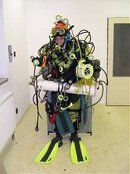I dive most often in Palm Beach County where we are constantly drifting and towing a dive float with a flag. We have strong currents, depths can be over 100 ft and we have a live boat following our float.
It is not that unusual for diver to get separated from the guy pulling the float, or even the guy pulling the float could set it down somewhere and have it pop loose and drift away. Now what?
The answer for me is to have a smb that I can deploy underwater. The sooner I get the float on the surface, the sooner I am likely to be located by the dive boat. If I have no means to deploy the float from underwater, then I would be motivated to rush my ascent and get to the surface ASAP, so I can waive my float in the air.
If you want to deal with the bother of a reel or a spool of line (in addition to carrying the SMB), then that is fine with me. In fact, if you can deploy from 90 feet deep (say the second you realize you lost the dive float (or the guy carrying it)..then this is probably the best response because you are drifting in a current.
HOWEVER, I do NOT carry a reel or spool for this type of situation. I use something that is simpler, smaller, cheaper, SAFER and more easily deployed. I wrap about 20 feet of string tightly around my smb, tie a metal clip to the end of the string and then secure everything with some elastic material.. thin bungi cord works well.
I cannot deploy the SMB from more than 20 ft or so, so I will drift some distance as I ascend from the bottom to this depth, but it is only going to be a few minutes. Once I get the smb on the surface, I can deflate my BC, hang on the string and know that the float is sticking up and the dive boat should be able to locate me soon.
In these situations, I prefer that the dive boat approach the float, gun the engine a few times – signaling me that they have located my float and then I can confidentially relax, complete my leisurely safety stop with no temptation to cut my safety stop time down to get to the surface and look around for the boat.
Even if they have to drive off and leave me to pick up another diver from the surface, I am still reasonably confident that they will be able to “remember” where I was when they left me.
In any regard, I have been using this configuration for like 20 years and have deployed the smb hundreds of times. Nobody teaches this configuration in a formal scuba class (that I know)..
This is a video of my 12 yr old learning to do it. He doesn’t do perfect, because it still takes some skill to control buoyancy in the water column without a good reference, but I think it does show how simple it is. You allow the clip on the end of the string to completely deploy and hang below the diver. There is (nearly) zero chance for entanglement because there is never any slack line. When the line is hanging straight down, you put a puff or two of air in the marker and let go, you let the string slide through your hands and when it stops going up you grab the line. If you do it right, the weighted line will stop at the exact depth you are hanging at.. Simpler than a reel or spool.. by far…
Skip to time = 35 seconds to see the child practicing the deployment.
https://www.youtube.com/watch?v=CE3cPJ40N7w
In this video, I film myself shooting the bag. This dive was a deco dive and I think my buddy was done with his deco earlier than me - so he goes up leaving me hanging.. so I send up my smb from 20 feet. You can see I am also carrying a large reel, which I CAN use to deploy a marker from the bottom, but my buddy had deployed a marker from the bottom on this dive.
Again, I have no problem with people using reels or spools to deploy from a depth of 50 or 100 or more than 150 ft, but it is NOT needed for most recreational divers.
Skip to time = 8:25
https://www.youtube.com/watch?v=uZJ0byuTVqU




